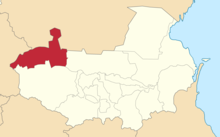Pyatigorsky Otdel
Пятигорскій отдѣлъ | |
|---|---|
 Location in the Terek Oblast | |
| Country | Russian Empire |
| Viceroyalty | Caucasus |
| Oblast | Terek |
| Established | 1785 |
| Abolished | 1924 |
| Capital | Pyatigorsk |
| Area | |
| • Total | 6,644.79 km2 (2,565.57 sq mi) |
| Population (1916) | |
| • Total | 200,486 |
| • Density | 30/km2 (78/sq mi) |
| • Urban | 40.75% |
| • Rural | 59.25% |
The Pyatigorsky Otdel[a] was a Cossack district (otdel) of the Terek Oblast of the Caucasus Viceroyalty of the Russian Empire. The area of the Pyatigorsky Otdel makes up part of the North Caucasian Federal District of Russia. The Pyatigorsky Otdel was eponymously named for its administrative center, Pyatigorsk.[1]
Administrative divisions[edit]
The subcounties (uchastoks) of the Pyatigorsky Otdel were as follows:[2]
| Uchastok | Russian name | 1912 population |
|---|---|---|
| 1st | 1-й участокъ | 43,052 |
| 2nd | 2-й участокъ | 27,072 |
Demographics[edit]
Russian Empire census (1897)[edit]
According to the Russian Empire census of 1897, the Pyatigorsky Otdel had a population of 181,481, including 93,961 men and 87,520 women. The majority of the population indicated Russian to be their mother tongue, with a significant Ukrainian speaking minority.[3]
| Language | Native speakers | % |
|---|---|---|
| Russian | 123,238 | 67.91 |
| Ukrainian | 25,032 | 13.79 |
| German | 5,872 | 3.24 |
| Ossetian | 4,620 | 2.55 |
| Armenian | 4,370 | 2.41 |
| Kabardian | 3,122 | 1.72 |
| Persian | 2,580 | 1.42 |
| Kalmyk | 2,174 | 1.20 |
| Circassian | 1,429 | 0.79 |
| Avar-Andean | 1,374 | 0.76 |
| Polish | 1,198 | 0.66 |
| Tatar[b] | 1,120 | 0.62 |
| Belarusian | 1,026 | 0.57 |
| Nogai | 900 | 0.50 |
| Georgian | 775 | 0.43 |
| Jewish | 476 | 0.26 |
| Greek | 338 | 0.19 |
| Romani | 276 | 0.15 |
| Bashkir | 271 | 0.15 |
| Lithuanian | 264 | 0.15 |
| Karachay | 197 | 0.11 |
| Kumyk | 175 | 0.10 |
| Chechen | 80 | 0.04 |
| Kazi-Kumukh | 96 | 0.05 |
| Romanian | 53 | 0.03 |
| Imeretian | 40 | 0.02 |
| Ingush | 23 | 0.01 |
| Turkmen | 17 | 0.01 |
| Dargin | 11 | 0.01 |
| Other | 334 | 0.18 |
| TOTAL | 181,481 | 100.00 |
Caucasian Calendar (1917)[edit]
According to the 1917 publication of the Caucasian Calendar, the Pyatigorsky Otdel had 200,486 residents in 1916, including 103,598 men and 96,888 women, 117,908 of whom were the permanent population, and 82,578 were temporary residents:[4]
| Nationality | Urban | Rural | TOTAL | |||
|---|---|---|---|---|---|---|
| Number | % | Number | % | Number | % | |
| Russians[c] | 71,569 | 87.61 | 110,791 | 93.26 | 182,360 | 90.96 |
| Other Europeans | 3,969 | 4.86 | 6,952 | 5.85 | 10,921 | 5.45 |
| Armenians | 3,664 | 4.49 | 337 | 0.28 | 4,001 | 2.00 |
| North Caucasians | 1,201 | 1.47 | 432 | 0.36 | 1,633 | 0.81 |
| Georgians | 849 | 1.04 | 13 | 0.01 | 862 | 0.43 |
| Jews | 324 | 0.40 | 1 | 0.00 | 325 | 0.16 |
| Shia Muslims[d] | 82 | 0.10 | 154 | 0.13 | 236 | 0.12 |
| Roma | 0 | 0.00 | 109 | 0.09 | 109 | 0.05 |
| Sunni Muslims[e] | 31 | 0.04 | 0 | 0.00 | 31 | 0.02 |
| Asiatic Christians | 0 | 0.00 | 8 | 0.01 | 8 | 0.00 |
| TOTAL | 81,689 | 100.00 | 118,797 | 100.00 | 200,486 | 100.00 |
Notes[edit]
- ^
- ^ Later known as Azerbaijani.
- ^ The Caucasian Calendar did not distinguish between Russians, Ukrainians, and Belarusians.
- ^ Primarily Tatars,[5] later known as Azerbaijanis.[6]
- ^ Primarily Turco-Tatars.[5]
References[edit]
- ^ Tsutsiev, Arthur (2014). Atlas of the Ethno-Political History of the Caucasus. Translated by Nora Seligman Favorov. New Haven: Yale University Press. ISBN 9780300153088.
- ^ Кавказский календарь на 1913 год [Caucasian calendar for 1913] (in Russian) (68th ed.). Tiflis: Tipografiya kantselyarii Ye.I.V. na Kavkaze, kazenny dom. 1913. pp. 180–187. Archived from the original on 19 April 2022.
- ^ a b "Демоскоп Weekly - Приложение. Справочник статистических показателей". www.demoscope.ru. Retrieved 2022-07-09.
- ^ Кавказский календарь на 1917 год [Caucasian calendar for 1917] (in Russian) (72nd ed.). Tiflis: Tipografiya kantselyarii Ye.I.V. na Kavkaze, kazenny dom. 1917. pp. 226–237. Archived from the original on 4 November 2021.
- ^ a b Hovannisian 1971, p. 67.
- ^ Bournoutian 2015, p. 35.
Bibliography[edit]
- Bournoutian, George (2015). "Demographic Changes in the Southwest Caucasus, 1604–1830: The Case of Historical Eastern Armenia". Forum of EthnoGeoPolitics. Amsterdam. 3 (2).
- Hovannisian, Richard G. (1971). The Republic of Armenia. Vol. 1. Berkeley: University of California Press. ISBN 0-520-01805-2.